Tutorial - Searching for and Acquiring the Components in Altium Designer
보드에 실장되는 실제 부품은 설계 캡처 시 회로도 심볼로 표시되며, 보드 설계 시에는 PCB 풋프린트로 표시됩니다. PCB 설계 프로젝트를 위한 부품은 회사의
컴포넌트 편집기( 단일 컴포넌트 편집 또는 배치 컴포넌트 편집 모드에서 작동 가능)를 사용하여 새 워크스페이스 라이브러리 컴포넌트가 생성되며, 여기서 모든 컴포넌트 데이터(회로도 기호, PCB 풋프린트, 파라미터, 부품 선택 등)를 수동으로 정의하거나 제공된 데이터를 사용할 수 있습니다
패널에 있는 모든 부품의 데이터를 기반으로 새로운 워크스페이스 라이브러리 구성 요소를 만들 수 있습니다
이 튜토리얼에서는 제조업체 부품 데이터를 사용하여 연결된 워크스페이스에 필요한 모든 컴포넌트를 생성합니다.
트랜지스터 찾기 및 획득하기
-
패널을 엽니다
Manufacturer Part Search 패널을 엽니다. 이렇게 하려면 디자인 공간의 오른쪽 하단에 있는 버튼을 클릭하고 메뉴에서
버튼을 클릭하고 메뉴에서 Manufacturer Part Search 를 선택합니다. -
패널 상단의
Search 패널 상단의 필드에transistor bc547Enter
-
검색 결과에서
BC547CG 트랜지스터의ON Semiconductor 에서 트랜지스터 항목을 클릭하여 결과 그리드에서 선택합니다. 표시되는SPNs 링크를 클릭하면 부품 가용성을 탐색할 수 있습니다.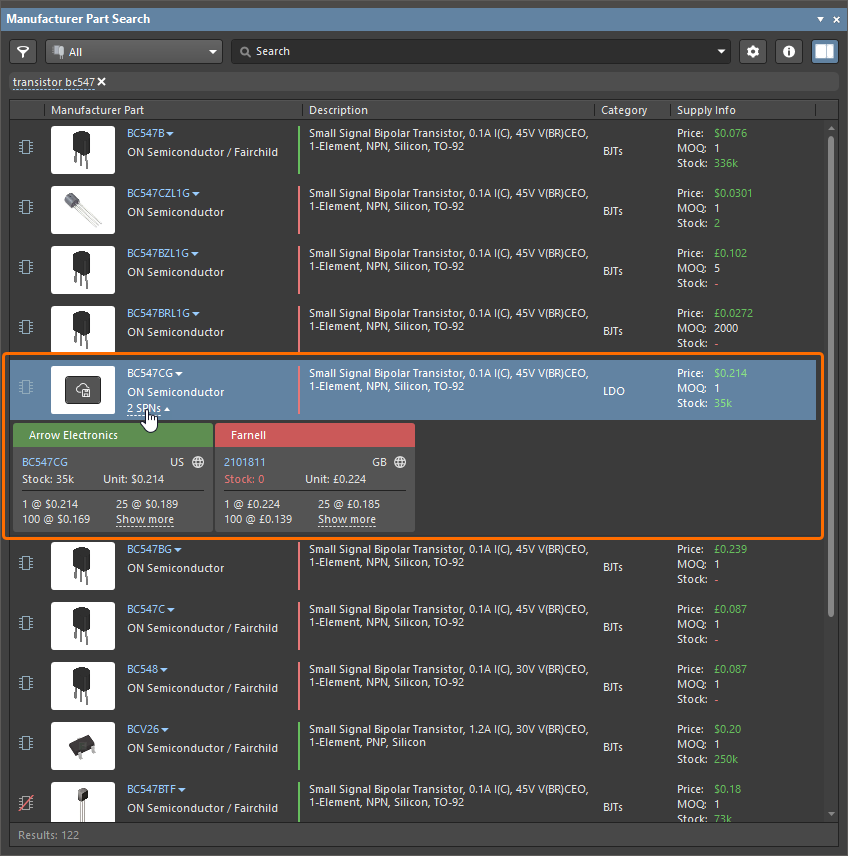
-
부품 항목의
 아이콘은 이 부품에 할당된 모델이 있음을 의미합니다. 창을 표시합니다(아직 표시되지 않은 경우)
아이콘은 이 부품에 할당된 모델이 있음을 의미합니다. 창을 표시합니다(아직 표시되지 않은 경우) Details 창(아직 표시되지 않은 경우 버튼)을 표시하여 선택한 부품의 매개변수 및 모델을 비롯한 세부 정보를 탐색할 수 있습니다.
버튼)을 표시하여 선택한 부품의 매개변수 및 모델을 비롯한 세부 정보를 탐색할 수 있습니다.
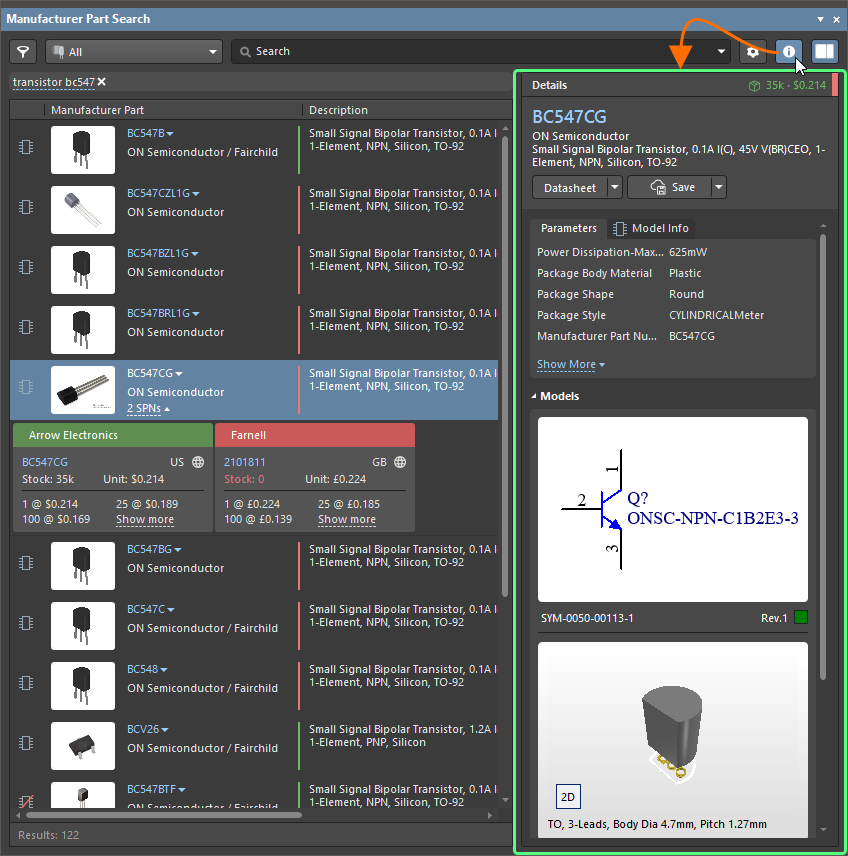
-
패널에서 트랜지스터가 선택되면 상단 영역의
 버튼을 클릭합니다
버튼을 클릭합니다 Details 창을 클릭합니다.
-
열리는
Create new component 대화 상자가 열리면Transistors 컴포넌트 유형을 선택하고OK .
-
열리는
Use Component Data 대화 상자가 열리면 대화 상자 상단의Show only matching with template 옵션이 비활성화되어 있는지 확인하고 헤더 행에서 옵션을 활성화합니다Parameters ,Models 및Datasheets 탭에서 옵션을 활성화하여 사용 가능한 모든 파라미터, 모델 및 데이터시트를 구성 요소에 추가한 다음OK . -
컴포넌트 에디터가 단일 컴포넌트 편집 모드로 열리고 선택한 데이터가 로드됩니다. 이 단계에서 심볼, 풋프린트 및 매개변수가 요구 사항을 준수하는지 확인하고 필요한 업데이트를 수행할 수 있습니다.

-
컴포넌트 항목 옆의
Save to Server 컴포넌트 항목 옆에 있는Projects 패널의 컴포넌트 항목 옆에 있는 컨트롤을 클릭합니다.
-
대화 상자가 열리면
Edit Revision for Item 대화 상자가 열리면 컴포넌트 리비전 릴리스에 대한 의미 있는 코멘트를Release Notes 필드(예Initial release of the transistor component saved from Manufacturer Part SearchOK . 컴포넌트가 워크스페이스에 저장되는 동안 상태 대화 상자가 열립니다. 이 작업이 완료되면 컴포넌트 편집기가 닫힙니다.
커패시터 찾기 및 획득하기
-
패널로 돌아가서
Manufacturer Part Search 패널로 돌아가서 패널의Search 필드에서capacitor 22 nF 16 V 0603 -
커패시터 항목을 선택합니다
C0603C223J4RACTU 커패시터KEMET 에서 커패시터 항목을 선택하고 버튼을 클릭합니다
버튼을 클릭합니다 Details 창을 클릭합니다. -
대화 상자가 열리면
Create new component 대화 상자가 열리면Capacitors 컴포넌트 유형을 선택하고OK . -
열리는
Use Component Data 대화 상자가 열리면 대화 상자 상단의Show only matching with template 옵션이 비활성화되어 있는지 확인하고 헤더 행에서 옵션을 활성화합니다Parameters ,Models 및Datasheets 탭에서 옵션을 활성화하여 사용 가능한 모든 파라미터, 모델 및 데이터시트를 구성 요소에 추가한 다음OK . -
컴포넌트 에디터가 열립니다. 컴포넌트의
Name 필드에서Component 영역의 필드에서 컴포넌트 이름을Capacitor 22nF +/-5% 16V 0603
-
컴포넌트 항목 옆에 있는
Save to Server 컴포넌트 항목 옆의Projects 패널에서 컴포넌트 항목 옆의 컨트롤을 클릭합니다. -
대화 상자가 열리면
Edit Revision for Item 대화 상자가 열리면 컴포넌트 리비전 릴리스에 대한 의미 있는 코멘트를Release Notes 필드(예Initial release of the capacitor component saved from Manufacturer Part SearchOK . 컴포넌트가 워크스페이스에 저장되는 동안 상태 대화 상자가 열립니다. 이 작업이 완료되면 컴포넌트 편집기가 닫힙니다.
저항기 찾기 및 획득하기
먼저 100K 저항을 검색해 보겠습니다.
-
패널로 돌아가서
Manufacturer Part Search 패널로 돌아가서 패널의Search 필드에서resistor 100 K 5% 0805 -
저항의 항목을 선택합니다
ERJ-6GEYJ104V 저항기Panasonic 에서 저항기 항목을 선택하고 버튼을 클릭합니다
버튼을 클릭합니다 Details 창을 클릭합니다. -
대화 상자가 열리면
Create new component 대화 상자가 열리면Resistors 컴포넌트 유형을 선택하고OK . -
열리는
Use Component Data 대화 상자가 열리면 대화 상자 상단의Show only matching with template 옵션이 비활성화되어 있는지 확인하고 헤더 행에서 옵션을 활성화합니다Parameters ,Models 및Datasheets 탭에서 옵션을 활성화하여 사용 가능한 모든 파라미터, 모델 및 데이터시트를 구성 요소에 추가한 다음OK . -
의
Name 필드에서Component 영역의 필드에서 컴포넌트 편집기 왼쪽 상단의 컴포넌트 이름을Resistor 100K +/-5% 0805 125 mW -
컴포넌트 항목 옆의
Save to Server 컴포넌트 항목 옆의Projects 패널에서 컴포넌트 항목 옆의 컨트롤을 클릭합니다. -
대화 상자가 열리면
Edit Revision for Item 대화 상자가 열리면 컴포넌트 리비전 릴리스에 대한 의미 있는 코멘트를Release Notes 필드(예Initial release of the resistor component saved from Manufacturer Part SearchOK . 컴포넌트가 워크스페이스에 저장되는 동안 상태 대화 상자가 열립니다. 이 작업이 완료되면 컴포넌트 편집기가 닫힙니다.
비슷한 방식으로 1K 저항을 찾아보겠습니다.
-
패널로 돌아가서
Manufacturer Part Search 패널로 돌아가서 패널의Search 필드에서resistor 1 K 5% 0805 -
저항의 항목을 선택합니다
ERJ-P06J102V 저항기Panasonic 에서 저항기 항목을 선택하고 버튼을 클릭합니다
버튼을 클릭합니다 Details 창을 클릭합니다. -
대화 상자가 열리면
Create new component 대화 상자가 열리면Resistors 컴포넌트 유형을 선택하고OK . -
열리는
Use Component Data 대화 상자가 열리면 대화 상자 상단의Show only matching with template 옵션이 비활성화되어 있는지 확인하고 헤더 행에서 옵션을 활성화합니다Parameters ,Models 및Datasheets 탭에서 옵션을 활성화하여 사용 가능한 모든 파라미터, 모델 및 데이터시트를 구성 요소에 추가한 다음OK . -
의
Name 필드에서Component 영역의 필드에서 컴포넌트 편집기 왼쪽 상단의 컴포넌트 이름을Resistor 1K +/-5% 0805 500 mW -
컴포넌트 항목 옆의
Save to Server 컴포넌트 항목 옆의Projects 패널에서 컴포넌트 항목 옆의 컨트롤을 클릭합니다. -
대화 상자가 열리면
Edit Revision for Item 대화 상자가 열리면 컴포넌트 리비전 릴리스에 대한 의미 있는 코멘트를Release Notes 필드(예Initial release of the resistor component saved from Manufacturer Part SearchOK . 컴포넌트가 워크스페이스에 저장되는 동안 상태 대화 상자가 열립니다. 이 작업이 완료되면 컴포넌트 편집기가 닫힙니다.
커넥터 찾기 및 가져오기
-
마지막으로 찾아야 할 컴포넌트는 2핀 헤더입니다. 2핀 헤더로 돌아가서
Manufacturer Part Search 패널로 돌아갑니다. 이번에는 패널의 패싯 검색 기능을 사용합니다. -
패널 왼쪽 상단의
Categories 패널의 왼쪽 상단에 있는 드롭다운에서All 항목을 확장하고Connectors 카테고리를 선택합니다.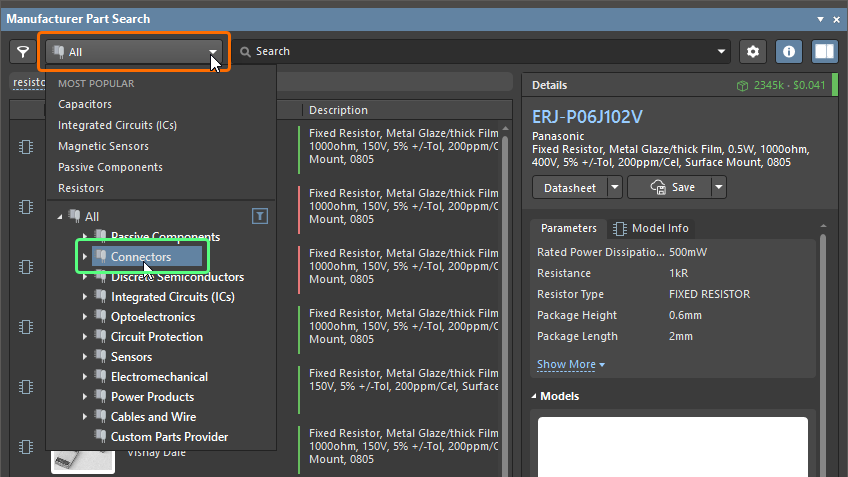
-
 버튼을 클릭하여
버튼을 클릭하여 Filters 창이 아직 표시되지 않은 경우 클릭합니다.
-
하단의
Show more filters 링크를 클릭하면Filters 창 하단의 링크를 클릭하면 가장 일반적으로 사용되는 필터가 아닌 사용 가능한 모든 필터가 표시됩니다.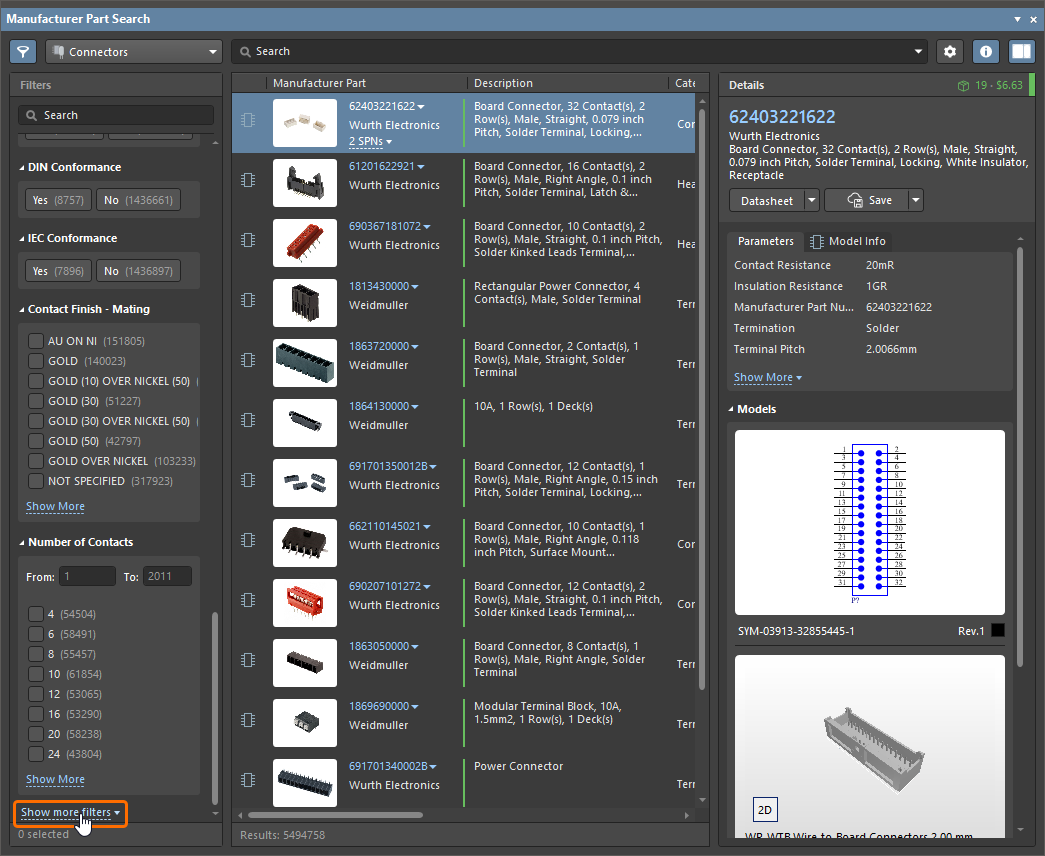
-
필터를 효율적으로 사용하는 방법은 상단에 있는
Search 패널 상단의Filters 창을 사용하는 것입니다. 검색하면 필터 이름이나 필터 설정에서 일치하는 문자열이 반환됩니다. 다음 검색어를 사용하여 필터를 적용하고 아래 나열된 옵션을 선택합니다:검색 대상 선택 model typeModel Type = 기호, 풋프린트contactsNumber of Contacts =2 pitchTerminal Pitch =2.54mm maleContact Gender =Male straightMounting Style =STRAIGHT 현재 선택된 필터 옵션은 검색창 아래에 표시됩니다.
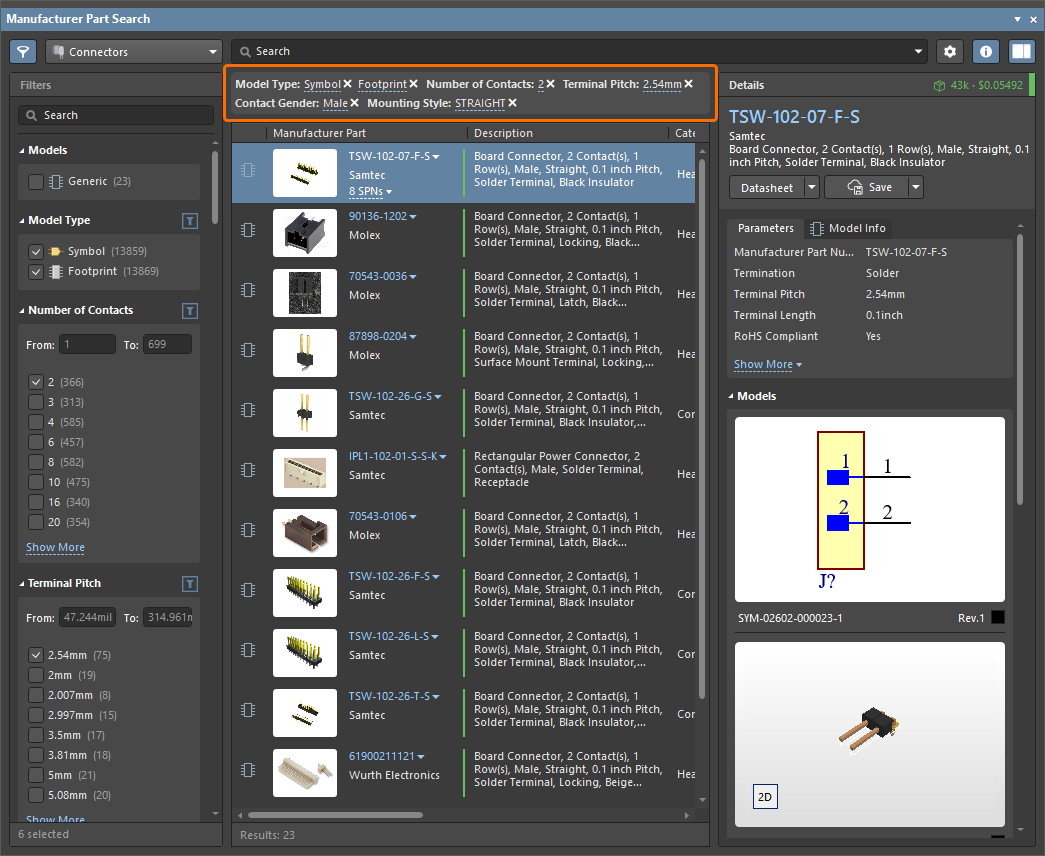
-
위와 같이 소수의 2핀 수직 수 헤더가 반환되어야 합니다. 다음과 같은 검색 결과에서 핀 피치가 2.54mm(0.1인치)인 적합한 2핀 수직 수 커넥터를 선택합니다
TSW-102-26-F-S 에서Samtec 을 클릭하고 버튼을 클릭합니다
버튼을 클릭합니다 Details 버튼을 클릭합니다. -
열리는
Create new component 대화 상자가 열리면Connectors 컴포넌트 유형을 선택하고OK . -
열리는
Use Component Data 대화 상자가 열리면 대화 상자 상단의Show only matching with template 옵션이 비활성화되어 있는지 확인하고 헤더 행에서 옵션을 활성화합니다Parameters ,Models 및Datasheets 탭에서 옵션을 활성화하여 사용 가능한 모든 파라미터, 모델 및 데이터시트를 구성 요소에 추가한 다음OK . -
컴포넌트 편집기에서 데이터 값을 기본값으로 두고 컴포넌트 항목 옆의
Save to Server 컴포넌트 항목 옆의Projects 패널에서 컴포넌트 항목 옆의 컨트롤을 클릭합니다. -
대화 상자가 열리면
Edit Revision for Item 대화 상자가 열리면 컴포넌트 리비전 릴리스에 대한 의미 있는 코멘트를Release Notes 필드(예Initial release of the connector component saved from Manufacturer Part SearchOK . 컴포넌트가 워크스페이스에 저장되는 동안 상태 대화 상자가 열립니다. 이 작업이 완료되면 컴포넌트 편집기가 닫힙니다.




 )
) AI-localized
AI-localized